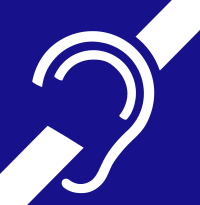
Photo from wikipedia
Introduction Hearing loss in adults has a pervasive impact on health and well-being. Its effects on everyday listening and communication can directly influence participation across multiple spheres of life. These… Click to show full abstract
Introduction Hearing loss in adults has a pervasive impact on health and well-being. Its effects on everyday listening and communication can directly influence participation across multiple spheres of life. These impacts, however, remain poorly assessed within clinical settings. Whilst various tests and questionnaires that measure listening and communication abilities are available, there is a lack of consensus about which measures assess the factors that are most relevant to optimising auditory rehabilitation. This study aimed to map current measures used in published studies to evaluate listening skills needed for oral communication in adults with hearing loss. Methods A scoping review was conducted using systematic searches in Medline, EMBASE, Web of Science and Google Scholar to retrieve peer-reviewed articles that used one or more linguistic-based measure necessary to oral communication in adults with hearing loss. The range of measures identified and their frequency where charted in relation to auditory hierarchies, linguistic domains, health status domains, and associated neuropsychological and cognitive domains. Results 9121 articles were identified and 2579 articles that reported on 6714 discrete measures were included for further analysis. The predominant linguistic-based measure reported was word or sentence identification in quiet (65.9%). In contrast, discourse-based measures were used in 2.7% of the articles included. Of the included studies, 36.6% used a self-reported instrument purporting to measures of listening for communication. Consistent with previous studies, a large number of self-reported measures were identified (n = 139), but 60.4% of these measures were used in only one study and 80.7% were cited five times or fewer. Discussion Current measures used in published studies to assess listening abilities relevant to oral communication target a narrow set of domains. Concepts of communicative interaction have limited representation in current measurement. The lack of measurement consensus and heterogeneity amongst the assessments limit comparisons across studies. Furthermore, extracted measures rarely consider the broader linguistic, cognitive and interactive elements of communication. Consequently, existing measures may have limited clinical application if assessing the listening-related skills required for communication in daily life, as experienced by adults with hearing loss.
Journal Title: Frontiers in Psychology
Year Published: 2022
Link to full text (if available)
Share on Social Media: Sign Up to like & get
recommendations!